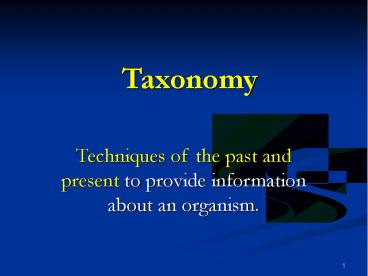Taxonomy PowerPoint PPT Presentation
Title: Taxonomy
1
Taxonomy
- Techniques of the past and present to provide
information about an organism.
2
Part OneHow it all started.
3
TAXA
- Greek word meaning categories or groups .
- Singular form of the term is taxon.
- Taxonomy the science that deals with the
classification or grouping of living things.
4
The first classification system
- 400 B.C. - Greek philosopher, Aristotle,
developed a system for sorting living organisms. - His system consisted of two kingdoms the plant
and animal kingdoms.
5
- Plants were grouped according to their stem
structure and size. The 3 subgroups were
Trees
Shrubs
6
- Animals were grouped according to habitat
Land
Water
Air
7
Gradually Aristotles system showed weaknesses.
Can you identify any?
- not specific enough
- too many organisms were being discovered
- The microscope discovered many organisms that
would not fit into Aristotles classification
system. - NOTE despite its weaknesses this first
classification system was used for about 2,000
years. - Who improved on this old system?
8
Beginnings of Modern Taxonomy
- 1600s
- John Ray - introduced a term called species.
- Stated that a species was a group of organisms
that were - similar in structure
- able to mate and pass the traits to their
offspring.
9
Founder of modern taxonomy
- Carolus Linnaeus (also in the 1600s)
- Also used structural similarities as the basis
for his taxonomic system - Started with a large group or kingdom which he
divided into subgroups - Organisms could be sorted more precisely
10
Todays taxonomy still uses Linnaeus system
- 7 Taxa / Groups
- 1. Kingdom
- 2. Phylum
- 3. Class
- 4. Order
- 5. Family
- 6. Genus
- 7. species
- Example human
- Animalia
- Chordata
- Mammalia
- Primates
- Hominidae
- Homo
- sapiens
11
King Philip Came Over For Green soup
12
Scientific Naming System
- There are always two Latin words to name each
species. - Process is called binomial nomenclature.
- Used world-wide to prevent confusion caused by
various languages. - Prevents confusion with common names.
- Example A puma, cougar and mountain lion are all
the same animal. Its scientific name, world-wide
is - Felis concolor
13
More about scientific naming
- The scientific name is composed of the Genus and
the species. - Rules for writing scientific names.
- Genus is given first and must be Capitalized and
underlined (or in italics) - Species name is second and must begin with a
lower case letter and must be underlined (or in
italics) - Example Homo sapiens or Homo sapiens
14
Other examples of scientific names
- Cats
- Wildcat
- Cougar
- Housecat
- Genus - Felis
- Felis sylvestris
- Felis concolor
- Felis domesticus or Felis domesticus
15
Review of the key terms
- Taxa
- Taxonomy
- Latin names
- Aristotle
- John Ray
- Carolus Linnaeus
- Species
- Kingdom
- Phylum
- Class
- Order
- Family
- Genus
- Binomial Nomenclature
16
Part TwoModern Methods
17
Today most scientists .
- recognize that organisms have changed over time.
- accept evolution as the basis for classification.
18
Phylogeny(phy-log-e-ny)
- The field of biology where scientists study the
evolutionary history of living organisms.
19
- Phylogenists often study fossils.
- 1. Fossil Records Fossils provide evidence that
show how plants and animals are related by
preserving structures that can be studied and
compared.
20
What is a fossil ?
- A cast or mold of an organism preserved in
rock that formed where the organism died.
Fish
Trilobite
Archaeopteryx
21
- A fossil may also consist of the organism
itself preserved in ice, amber, or in volcanic
glass.
Cockroach in amber
Can you guess what these are?
Firefly
22
- A fossil may also consist of tracks
(footprints), seeds, or skeleton preserved in
deposits (sediments).
23
2. Homologous Structures
- are parts in different animals that show
similarities in their structure.
- Ex.- a bat wing, a human arm, a whale flipper and
a cat foreleg are all homologous structures.
24
3. Comparative Embryology
- Taxonomists study the patterns of development
- before birth. Embryos of organisms believed to
- be closely related show similar patterns of
- development.
Dolphin embryo
Human embryo
25
Modern Methods (contd)
- 4. Comparative biochemistry the study of the
chemistry of blood, enzymes and other specific
substances produced by animals and plants. - Example hemoglobin in the blood cells of
gorillas and humans are the same except for one
amino acid. - 5. Comparing sequences of amino acids in
organisms helps to reveal relationships. - Q. What determines the sequence of these amino
acids ? - A. DNA
26
Modern Methods (contd)
- 6. Comparative DNA and RNA Scientists now study
DNA and RNA structure to see their similarities
among organisms. - DNA of humans and chimpanzees is 96 identical.
- DNA between humans and other mammals
(dog,horses,whales,bats,etc) is only about 80
identical.
27
Modern Methods (contd)
- 7. Function what the organism does its place in
the ecosystem. - 8. Behavior series of activities performed by an
organism in response to stimuli. - 9. Nutrition what an organism eats
28
Final Thoughts
- It is important to recognize that a taxonomic
classification system is not a fact. - Classification is based on educated opinions and
as a result there are a number of ways in which
organisms can be grouped.

